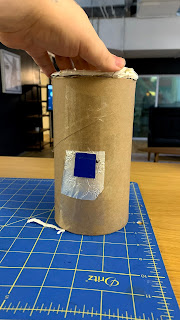Cameras & How They Function
The course Light, Sound, & Time is about investigating how and why we perceive things like light, sound, and time the way we do. This unit focused mainly on light and time and investigated how we perceive light and why we see it the way we do along with how time can affect how we see light. Because of this unit I learned the process that light takes for it to reach the eye and how the eye processes the light so that we can see light and images. For the action project we had the option to build either a camera obscura or pinhole camera and investigate how cameras capture images. I am most proud of being able to learn how to develop photos in a darkroom on my own and go through that process because I have been meaning to develop my own roll of film and it was nice to get that experience.
In order to make my pinhole camera, I painted an old oatmeal can black on the inside to lightproof it. Along with the top of the can. I made a hole in the middle originally at the size of a quarter then used tinfoil to cover the hole. I used a thumbtack to pierce a hole in the tin foil to act at the lens. Then I used a piece of cardboard to act as a cover. Due to the top of my can being translucent, I believe that my photos turned out the way they did because light was able to enter the camera body through the top.
The purpose of my camera was to bring to life the idea of reflection because the white paper reflects the image that is being captured and the black shadows form due to the paper absorbing light. My device demonstrates the key science that light is a particle because the light left dark spots on the photo paper.
Some of the measurements of the camera include: the distance from my lens to my paper was about 4 inches. The height of my pinhole was 3.25 inches. The height of the subject (me) was 62 inches. Using similar triangles the minimum distance my camera has to be from the subject is 50.375 inches.
62 x 4/3.25 =
4/3.25=62/x
4x/4= 201.5/4
x=50.375 in
Based on the dimensions, the volume of the camera is
V=pi x 2^2 x 7
Which means V= 87.96 cubic units
The “shutter speed” for my pinhole camera was 5 minutes. My images for the most part turned out black, meaning there was too much light in the camera.
One takeaway from this AP would be how time can very much affect light and how light can easily be picked up. If I could do the project over again I would have a shorter “shutter speed” because I feel the 5 minutes was way too long. I would shorten my time down to a minute or even 30 seconds.
Citations: KE's Pinhole Camera & Results, Jan 2021.






Comments
Post a Comment